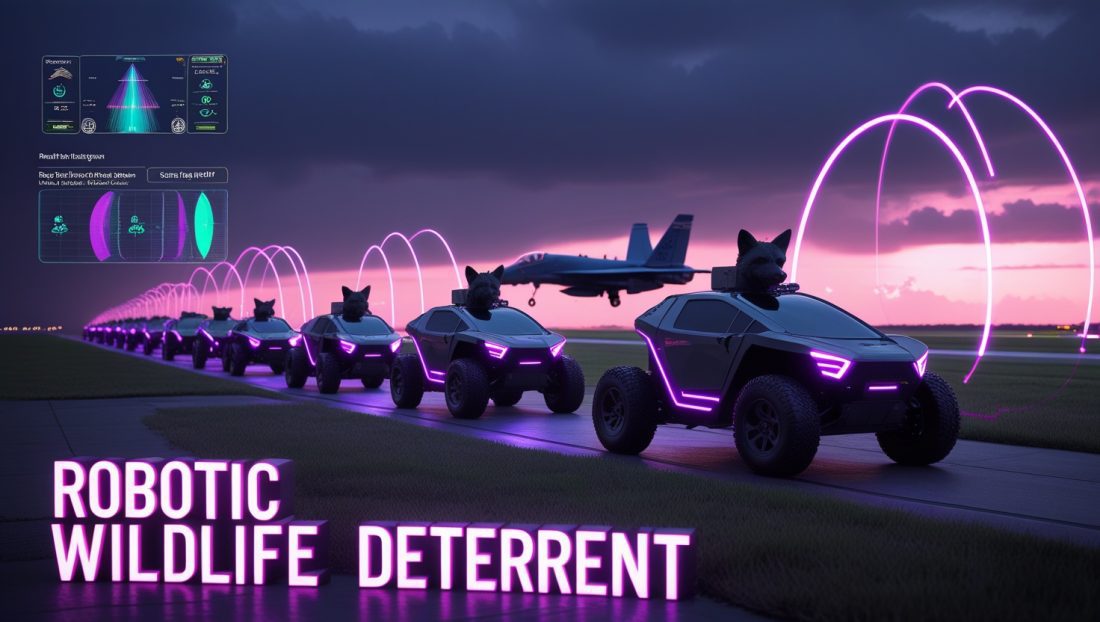The U.S. Army Engineer Research and Development Center (ERDC) is deploying robotic wildlife deterrent systems, known as robotic coyotes, at military airfields to combat wildlife threats costing $817M in damages since 1995. These unmanned ground vehicles (UGVs), dubbed “Coyote Rovers,” combine $3,000 off-the-shelf components with industrial AI to scare birds from fighter jets during critical operations. Tested at Naval Air Stations in Florida and Tennessee since 2024, they address a lethal problem: 90% of bird strikes occur below 2,000 feet during takeoff/landing, endangering pilots and aircraft like the Navy’s Blue Angels.
The $1B Bird Strike Crisis
Wildlife Threats by the Numbers
- Financial Toll: The U.S. Air Force recorded 45,440 wildlife strikes from 2007–2016 alone, causing $251M in damage. Canada geese top the threat list, responsible for $93.8M in Air Force damages from 1995–2016.
- Human Cost: In 2014, four Air Force crew members died when geese shattered their helicopter’s windshield mid-flight, disabling controls.
- Operational Disruptions: Naval bases lose $20M/year from wildlife interference, including submarine damage from seagulls and equipment corrosion from nesting animals.
Evergreen Takeaway: Wildlife threats scale with aviation activity. Civilian airports face identical risks—global bird strikes cause $1.2B/year in damages. To understand how autonomous systems are tackling similar challenges in other domains, explore how aerial construction drones are enhancing safety by reducing human exposure to hazardous environments.
Coyote Rovers: A Robotic Wildlife Deterrent with High Impact
Design Evolution
ERDC biologists Shea Hammond and Dr. Jacob Jung spent five years prototyping solutions. Their initial attempt used Boston Dynamics’ $74,500 Spot robot, but its slow speed failed to scare animals. “It pushed them away instead of scaring them off,” Jung noted.
The breakthrough came from:
- Traxxas X-Maxx Chassis: Radio-controlled cars ($2,500–$3,000 total) hitting 20 mph to chase wildlife effectively.
- Plastic Coyote Decoys: Life-sized figures from forestry suppliers, triggering prey animals’ instinctual fear.
- Autonomous Systems: Pre-programmed routes, exclusion zones (e.g., active runways), and docking stations for multi-day operations.
Field Impact: At Fort Campbell and NAS Pensacola, tests reduced grass-mowing cycles by 1–2 weeks—a major cost saver. The rovers’ speed and predator mimicry created persistent “landscape fear,” preventing habituation. For a deeper dive into how robotics simulations are replacing costly physical prototypes, check out this analysis of robotics simulation advancements.
Industrial AI Integration: The Future of Wildlife Mitigation
Machine Learning Upgrades
While current models are radio-controlled, ERDC plans AI enhancements to:
- Identify Species: Customize tactics per animal (e.g., rapid moves for geese, sounds for raptors).
- Predict Movements: Radar systems like Merlin Bird Radar (detecting objects as small as 2mm) could feed data to rovers, targeting high-risk zones proactively. Learn more about how AI-driven predictive maintenance is optimizing operational efficiency in similar high-stakes environments.
- Enable Swarm Coordination: Deploy rover fleets across large airfields using mesh networking.
Industrial AI Analysis: Unlike generic drones, purpose-built robots leverage “instinct-driven” efficiency. The coyote’s natural role as an apex mesopredator makes it ideal for cross-species deterrence—an insight AI will refine. For further reading on how AI enhances decision-making in robotics, the U.S. Air Force Research Laboratory provides insights into cutting-edge defense tech innovations.
Beyond Airfields: Civilian and Infrastructure Applications
Scalable Solutions
ERDC confirms identical systems could:
- Secure Dams/Locks: Prevent nesting that corrodes critical infrastructure.
- Port Operations: Aquatic versions on boats could deter birds from cargo ships.
- Agriculture: Protect crops from foraging species without lethal measures. For a broader perspective on robotics in environmental applications, the National Wildlife Research Center discusses non-lethal wildlife management strategies.
Fictional Anecdote: “During a demo at Pensacola, a rover herd flushed 47 black vultures from an F/A-18 engine intake in 90 seconds. It felt like watching a chess match between evolution and engineering,” an Air Force technician remarked.
Toward Autonomous Wildlife Management
The Coyote Rovers exemplify industrial pragmatism: solving billion-dollar problems with affordable, adaptable tech. Future iterations will likely merge with DoD’s $850B modernization budget, expanding into perimeter security and disaster-site monitoring. For global aviation, this model proves wildlife mitigation requires neither bullets nor lasers—just smarter, faster mimics of nature.
“Sometimes low-tech is high-impact. A $3,000 robot coyote might save a $100 million jet.”
— Shea Hammond, ERDC Research Biologist



